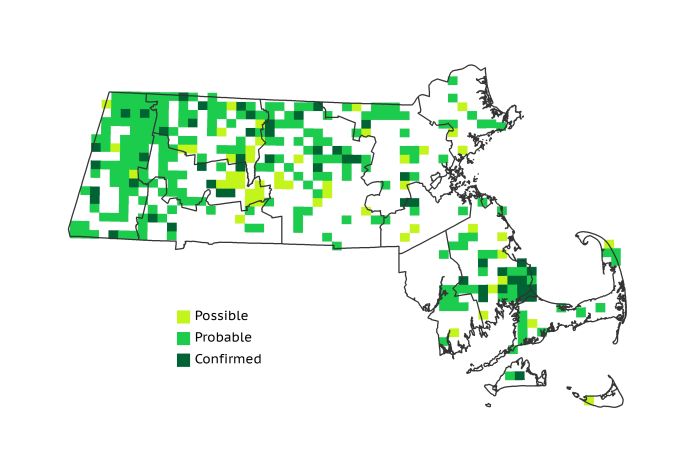Find a Bird
Hermit Thrush
Catharus guttatus

Widespread and likely increasing

“Solitary, the thrush, / The hermit, withdrawn to himself, avoiding the settlements, / Sings by himself a song.” – Walt Whitman, “When Lilacs Last in the Dooryard Bloom’d”
Walt Whitman was one of many people to admire the song of the Hermit Thrush. The lilting and ethereal voice of this species has won it praise throughout its extensive breeding range. Hermit Thrushes can be found nesting throughout northern forests from New England to Alaska, as well as in much of the Rocky Mountains and the western United States. Although they are often thought of as birds of the deep woods (hence the name “hermit”), Hermit Thrushes have proven to be quite broad in their selection of breeding territory.
Historic Status
The people of Maine apparently knew something that most ornithologists of the time did not in the middle of the 1840s. Privileged to hear the songs of both the Swainson's Thrush and the Hermit Thrush, they knew them to be separate species. It took the Smithsonian’s Spencer Fullerton Baird to make the suggestion nationally in 1844 that the “Ground Swamp Robin,” or Hermit Thrush, might not be the same as the “Swamp Robin” or Swainson's Thrush (Baird et al 1874). Baird et al also noted that the species’ southern breeding range at that time barely reached into Massachusetts, and only at the higher elevations in the western parts of the state at that. The Hermit Thrush was apparently a victim of deforestation during the early years of European settlement. By the 1920s, Maurice Broun, writing in Forbush's Birds of Massachusetts and Other New England States, stated that “in late years,” with reforestation, the Hermit Thrush had become increasingly widespread (Forbush 1929).
Atlas 1 Distribution
By Atlas 1 Hermit Thrushes were returning to their former haunts along with the forests, and were found in 35% of the blocks surveyed. Most western ecoregions had a healthy distribution of Hermit Thrushes, especially the Berkshire Highlands with 86% block occupancy. The low-elevation, largely cleared habitats of the Connecticut River Valley reported only 29% occupancy, but numbers were higher in the Lower Worcester Plateau and especially in the Worcester Plateau. Hermit Thrushes were present but more sparingly distributed in the Coastal Plains and Boston Basin. The Bristol/Narragansett Lowlands and the Cape and Islands ecoregions both had pockets of Hermit Thrush activity, especially where pine barrens existed, but the thrushes were present in only about a quarter of each region.
Atlas 2 Distribution and Change
Hermit Thrushes continued their recolonization of Massachusetts, and their “richly melodious, haunting, fluty warble” (Dellinger et al 2012) rang throughout their still expanding Atlas 2 distribution. They were found in 60% of the blocks surveyed during Atlas 2, and every region posted an increase in block occupancy. While the highest block occupancy rates are still in the forested highlands of our western regions, Hermit Thrushes made notable gains in several eastern regions, especially the Coastal Plains. As with several other expanding species, this range extension was accomplished by both persistence and new colonization – not a shift in their range.
Atlas 1 Map

Atlas 2 Map

Atlas Change Map

Ecoregion Data
Atlas 1 | Atlas 2 | Change | ||||||
Ecoregion | # Blocks | % Blocks | % of Range | # Blocks | % Blocks | % of Range | Change in # Blocks | Change in % Blocks |
Taconic Mountains | 12 | 75.0 | 3.6 | 24 | 96.0 | 3.9 | 3 | 20.0 |
Marble Valleys/Housatonic Valley | 21 | 53.8 | 6.2 | 31 | 79.5 | 5.0 | 10 | 25.6 |
Berkshire Highlands | 47 | 85.5 | 13.9 | 55 | 100.0 | 8.9 | 6 | 11.3 |
Lower Berkshire Hills | 14 | 50.0 | 4.1 | 28 | 90.3 | 4.5 | 12 | 44.4 |
Vermont Piedmont | 8 | 47.1 | 2.4 | 17 | 100.0 | 2.7 | 4 | 33.3 |
Berkshire Transition | 19 | 50.0 | 5.6 | 39 | 97.5 | 6.3 | 13 | 41.9 |
Connecticut River Valley | 16 | 28.6 | 4.7 | 35 | 53.8 | 5.6 | 12 | 25.0 |
Worcester Plateau | 46 | 59.0 | 13.6 | 87 | 98.9 | 14.0 | 18 | 37.5 |
Lower Worcester Plateau | 30 | 40.5 | 8.9 | 61 | 76.3 | 9.8 | 15 | 27.8 |
S. New England Coastal Plains and Hills | 59 | 21.9 | 17.5 | 153 | 54.1 | 24.7 | 73 | 32.3 |
Boston Basin | 5 | 8.9 | 1.5 | 11 | 19.6 | 1.8 | 6 | 10.9 |
Bristol and Narragansett Lowlands | 27 | 25.5 | 8.0 | 31 | 27.2 | 5.0 | 2 | 2.0 |
Cape Cod and Islands | 34 | 25.0 | 10.1 | 48 | 33.3 | 7.7 | 9 | 7.5 |
Statewide Total | 338 | 34.9 | 100.0 | 620 | 59.8 | 100.0 | 183 | 22.1 |
Notes
The Hermit Thrush shows a significant increasing Breeding Bird Survey trend in the Eastern US overall.



